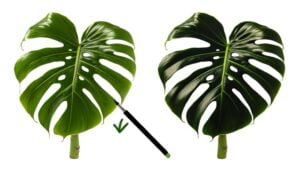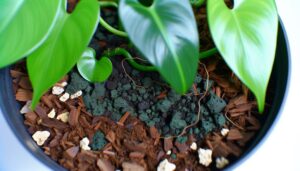Comparison: Rhaphidophora Tetrasperma Vs Monstera Deliciosa
Rhaphidophora tetrasperma and Monstera deliciosa, both Araceae family members, showcase distinctive characteristics shaped by their origins in Southeast Asia and Central-South America. Monstera deliciosa is renowned for its large, fenestrated leaves up to 3 feet long, aiding epiphytic growth.
Rhaphidophora tetrasperma has smaller, more delicate leaves with shallow lobes. While Monstera deliciosa prefers rich, organic soil and medium to bright indirect light, Rhaphidophora tetrasperma favors well-draining soil under bright, indirect light.
Both species face similar pest challenges, like spider mites and aphids. Understanding these differences enhances your appreciation for each unique species.
Learn about their propagation and uses next.
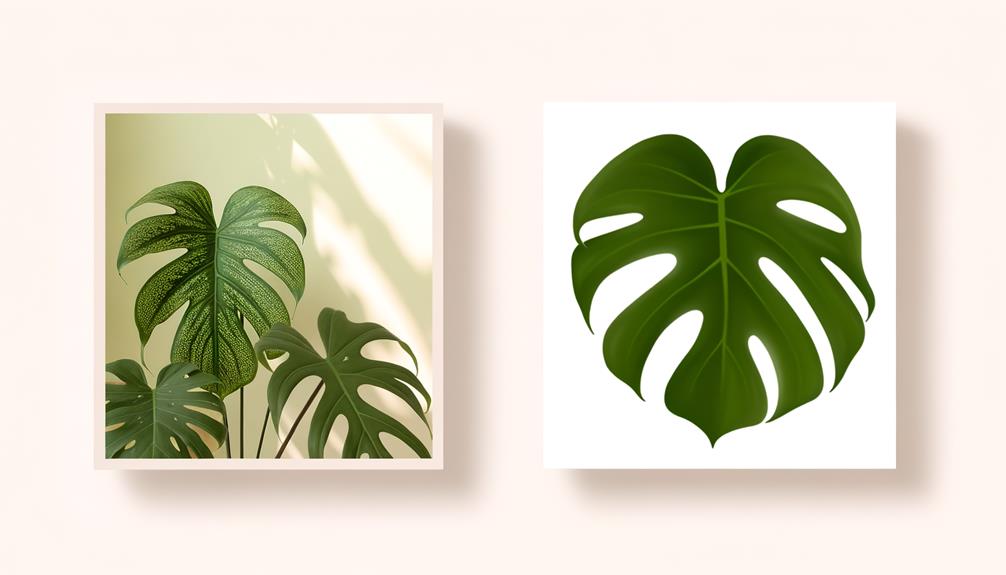
Key Takeaways
- Rhaphidophora tetrasperma has smaller, delicate leaves, while Monstera deliciosa has large, fenestrated leaves up to 3 feet long.
- Rhaphidophora tetrasperma prefers bright, indirect light, while Monstera deliciosa thrives in medium to bright indirect light.
- Monstera deliciosa is native to Central and South America; Rhaphidophora tetrasperma originates from Southeast Asia.
- Both species are susceptible to pests like spider mites and diseases such as root rot and powdery mildew.
- Rhaphidophora tetrasperma climbs using aerial roots, whereas Monstera deliciosa exhibits both climbing and sprawling growth habits.
Origin and Background

Rhaphidophora tetrasperma, commonly known as the mini monstera, originates from the tropical regions of Southeast Asia, while Monstera deliciosa, also known as the Swiss cheese plant, is native to the rainforests of Central and South America. Both species belong to the Araceae family, yet their geographic origins influence their growth habits and ecological niches.
Rhaphidophora tetrasperma thrives in humid, lowland forests, often climbing tree trunks using its aerial roots, displaying a vigorous vining habit. Conversely, Monstera deliciosa is adapted to the dense, humid canopies, where it exhibits epiphytic growth, often ascending large trees to access sunlight.
Understanding these origins elucidates their care requirements and adaptability when cultivated indoors or in botanical gardens.
Leaf Structure
The leaf structure of Monstera deliciosa is characterized by its large, fenestrated leaves, which can grow up to three feet long, featuring deep splits and distinctive holes that contribute to its common name, the Swiss cheese plant. These fenestrations provide increased light penetration and airflow, critical for its epiphytic growth in tropical rainforests.
In contrast, Rhaphidophora tetrasperma exhibits smaller, more delicate leaves, typically reaching about 6-12 inches in length. While they also display fenestrations, these are less pronounced and more uniform compared to Monstera deliciosa. The lobes of Rhaphidophora tetrasperma are more linear and narrowly separated.
Both species exhibit glossy, dark green foliage, but the overall leaf morphology reflects their distinct evolutionary adaptations to similar yet unique ecological niches.
Growth Habits
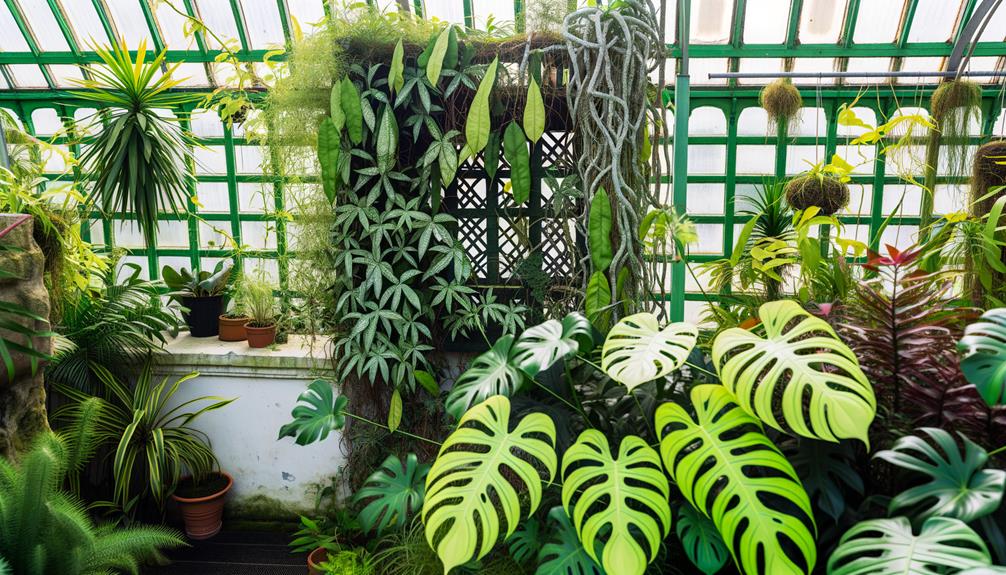
Rhaphidophora tetrasperma exhibits a vigorous climbing habit, utilizing aerial roots to ascend supports, whereas Monstera deliciosa demonstrates a combination of climbing and sprawling growth patterns, often extending horizontally when support is unavailable.
Leaf morphology also varies considerably, with Rhaphidophora tetrasperma producing smaller, more delicate fenestrated leaves compared to the larger, more robust and deeply lobed leaves of Monstera deliciosa.
These differences in growth habits and leaf structure markedly influence their respective spatial and environmental requirements.
Climbing Vs. Sprawling Growth
Monstera deliciosa demonstrates a sprawling growth habit, spreading horizontally with its large, fenestrated leaves, while Rhaphidophora tetrasperma climbs vertically, utilizing aerial roots to attach to supports and ascend.
This distinction in growth habits is essential for horticulturists and indoor plant enthusiasts. Monstera deliciosa's lateral expansion necessitates ample horizontal space and staking for best growth. In contrast, Rhaphidophora tetrasperma's epiphytic nature allows it to thrive in vertical arrangements, often employing moss poles or trellises for support.
The aerial roots of Rhaphidophora tetrasperma efficiently anchor the plant, allowing it to climb and maximize spatial efficiency. Understanding these divergent growth strategies aids in creating tailored care regimens, ensuring both species flourish in their intended environments.
Leaf Size and Shape
While examining the contrasting growth habits of these species, attention must also be given to the distinct differences in leaf size and shape. Rhaphidophora tetrasperma, often referred to as 'Mini Monstera,' exhibits smaller, deeply fenestrated leaves that typically reach 6-12 inches in length. In contrast, Monstera deliciosa, or the 'Swiss Cheese Plant,' produces notably larger leaves, often exceeding 18 inches, with prominent perforations and lobes. These morphological characteristics are indispensable in differentiating the two species and understanding their growth dynamics.
| Species | Leaf Size | Leaf Shape |
|---|---|---|
| Rhaphidophora tetrasperma | 6-12 inches | Deeply fenestrated, smaller |
| Monstera deliciosa | 18+ inches | Large, perforated, lobed |
This comparative analysis elucidates their distinctive foliage, reflective of their adaptive growth strategies.
Care Requirements
Both species demand specific care regimens to thrive, including particular light, water, and soil requirements that cater to their unique growth habits. Rhaphidophora tetrasperma, often dubbed 'Mini Monstera,' prefers bright, indirect light and well-draining, aerated soil to prevent root rot. It thrives in moderate humidity and requires consistent but not waterlogged moisture levels.
Monstera deliciosa, known for its larger, fenestrated leaves, demands similar light conditions but can tolerate slightly lower humidity. It benefits from rich, organic soil and periodic deep watering, allowing the top inch of the soil to dry between waterings. Both species appreciate occasional fertilization during the growing season, promoting robust foliage and healthy growth.
Proper attention ensures these tropical plants flourish in their respective environments.
Common Pests and Diseases
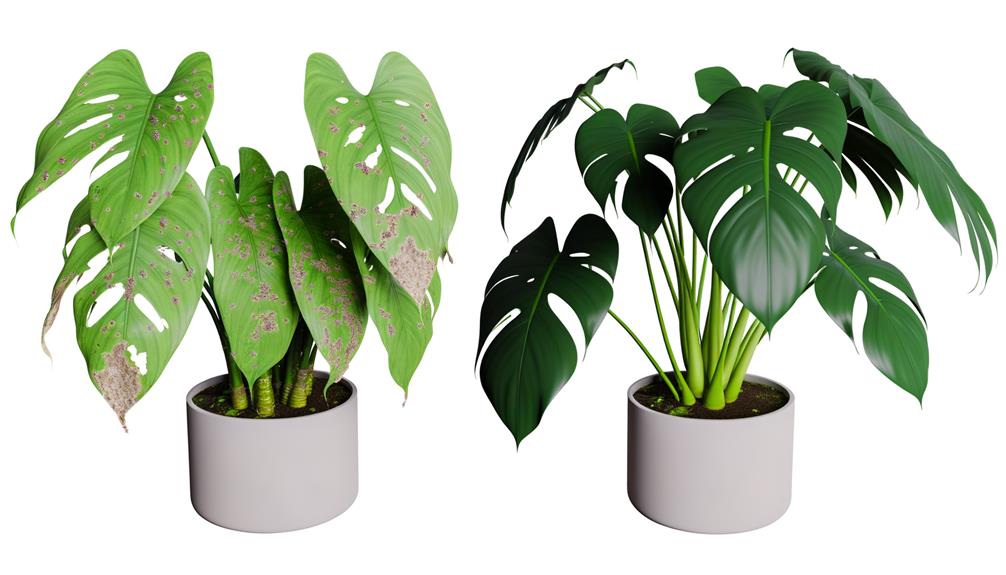
In addition to their specific care requirements, Rhaphidophora tetrasperma and Monstera deliciosa are susceptible to a range of common pests and diseases that can hinder their growth and health. Both species frequently encounter spider mites, aphids, and mealybugs, which feed on their sap, causing chlorosis and stunted growth.
Scale insects and thrips can also infest these plants, leading to leaf deformation and discoloration. Fungal diseases such as root rot, caused by overwatering, and powdery mildew, thrive in high humidity and poor airflow, affecting foliage integrity. Bacterial leaf spot, characterized by water-soaked lesions, can rapidly spread in humid conditions.
Regular monitoring and maintaining ideal environmental conditions are crucial to preventing and managing these pest and disease issues effectively.
Propagation Methods
Propagation of Rhaphidophora tetrasperma and Monstera deliciosa can be efficiently achieved through stem cuttings, which, when placed in suitable growing conditions, develop roots and new growth. The propagation process involves several specific steps:
- Cutting Selection: Choose a healthy stem with at least one node and aerial root to guarantee successful root development.
- Medium Preparation: Place the cutting in water or a well-draining soil mix, ensuring appropriate moisture and aeration.
- Environmental Conditions: Maintain high humidity and indirect light to promote growth and root formation.
These methods leverage the plants' natural growth habits, wherein nodes and aerial roots are crucial for nutrient uptake and stability. Understanding these techniques guarantees robust growth and propagation success for both species.
Popularity and Uses

Renowned for their unique foliage and adaptability, Rhaphidophora tetrasperma and Monstera deliciosa have garnered significant popularity among plant enthusiasts and interior decorators alike.
The compact Rhaphidophora tetrasperma, often referred to as 'mini Monstera,' exhibits fenestrated leaves and thrives in smaller spaces, making it ideal for urban environments.
Conversely, the Monstera deliciosa, with its large, perforated leaves, commands attention in expansive interiors, contributing a bold, tropical aesthetic.
Both species are valued not only for their ornamental appeal but also for their air-purifying properties, enhancing indoor air quality.
Their climbing growth habits necessitate structural support, such as moss poles, to mimic their natural epiphytic tendencies, ensuring robust development and lush foliage.
Consequently, these plants are both practical and visually striking in various settings.
Conclusion
The unparalleled allure of both Rhaphidophora tetrasperma and Monstera deliciosa cannot be overstated. Their distinct leaf structures, unique growth habits, and varied care requirements create a riveting dichotomy that captivates horticultural enthusiasts.
Despite their susceptibility to specific pests and diseases, these species' propagation methods offer endless fascination. Their soaring popularity and versatile uses further underscore their botanical magnificence.
The study of these plants is not merely an interest but a profound exploration into the marvels of nature.

